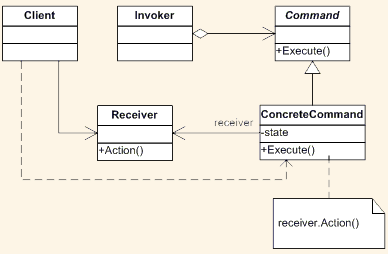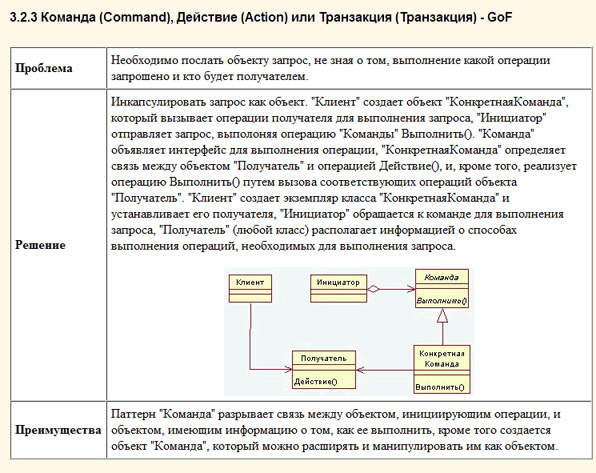Command in VB.NET
Encapsulate a command request as an object
ReturnEncapsulate a request as an object, thereby letting you parameterize clients with different requests, queue or log requests, and support undoable operations. Command pattern which stores requests as objects allow clients to execute or playback the requests.


Please download project with this source code from https://github.com/ViacheslavUKR/StandardDisignOopPattern
1: ' Command Design Pattern.
2: ' See description in //www.vb-net.com/ProgramTheory/Command.htm
3: Class MainApp
4: ' Entry point into console application.
5: Public Shared Sub Main()
6: ' Create receiver, command, and invoker
7: Dim receiver As New Receiver()
8: Dim command As Command = New ConcreteCommand(receiver)
9: Dim invoker As New Invoker()
10: ' Set and execute command
11: invoker.SetCommand(command)
12: invoker.ExecuteCommand()
13: ' Wait for user
14: Console.ReadKey()
15: End Sub
16: End Class
17:
18: ' The 'Command' abstract class
19: MustInherit Class Command
20: Protected receiver As Receiver
21: ' Constructor
22: Public Sub New(receiver As Receiver)
23: Me.receiver = receiver
24: End Sub
25: Public MustOverride Sub Execute()
26: End Class
27:
28: ' The 'ConcreteCommand' class
29: Class ConcreteCommand
30: Inherits Command
31: ' Constructor
32: Public Sub New(receiver As Receiver)
33: MyBase.New(receiver)
34: End Sub
35: Public Overrides Sub Execute()
36: receiver.Action()
37: End Sub
38: End Class
39:
40: ' The 'Receiver' class
41: Class Receiver
42: Public Sub Action()
43: Console.WriteLine("Called Receiver.Action()")
44: End Sub
45: End Class
46:
47: ' The 'Invoker' class
48: Class Invoker
49: Private _command As Command
50: Public Sub SetCommand(command As Command)
51: Me._command = command
52: End Sub
53: Public Sub ExecuteCommand()
54: _command.Execute()
55: End Sub
56: End Class

See also:
Creational Patterns
- Abstract Factory in VB.NET - Creates an instance of several families of classes.
- Builder in VB.NET - Separates object construction from its representation.
- Factory Method in VB.NET - Creates an instance of several derived classes.
- Prototype in VB.NET - A fully initialized instance to be copied or cloned.
- Singleton in VB.NET - A class of which only a single instance can exist.
- Adapter in VB.NET - Match interfaces of different classes
- Bridge in VB.NET - Separates an object’s interface from its implementation
- Composite in VB.NET - A tree structure of simple and composite objects
- Decorator in VB.NET - Add responsibilities to objects dynamically
- Facade in VB.NET - A single class that represents an entire subsystem
- Flyweight in VB.NET - A fine-grained instance used for efficient sharing
- Proxy in VB.NET - An object representing another object
- Chain of Resp. in VB.NET - A way of passing a request between a chain of objects
- Command in VB.NET - Encapsulate a command request as an object
- Interpreter in VB.NET - A way to include language elements in a program
- Iterator in VB.NET - Sequentially access the elements of a collection
- Mediator in VB.NET - Defines simplified communication between classes
- Memento in VB.NET - Capture and restore an object's internal state
- Observer in VB.NET - A way of notifying change to a number of classes
- State in VB.NET - Alter an object's behavior when its state changes
- Strategy in VB.NET - Encapsulates an algorithm inside a class
- Template Method in VB.NET - Defer the exact steps of an algorithm to a subclass
- Visitor in VB.NET - Defines a new operation to a class without change
Comments (
 )
)
 )
)
Link to this page:
//www.vb-net.com/ProgramTheory/Command.htm
| <SITEMAP> <MVC> <ASP> <NET> <DATA> <KIOSK> <FLEX> <SQL> <NOTES> <LINUX> <MONO> <FREEWARE> <DOCS> <ENG> <CHAT ME> <ABOUT ME> < THANKS ME> |